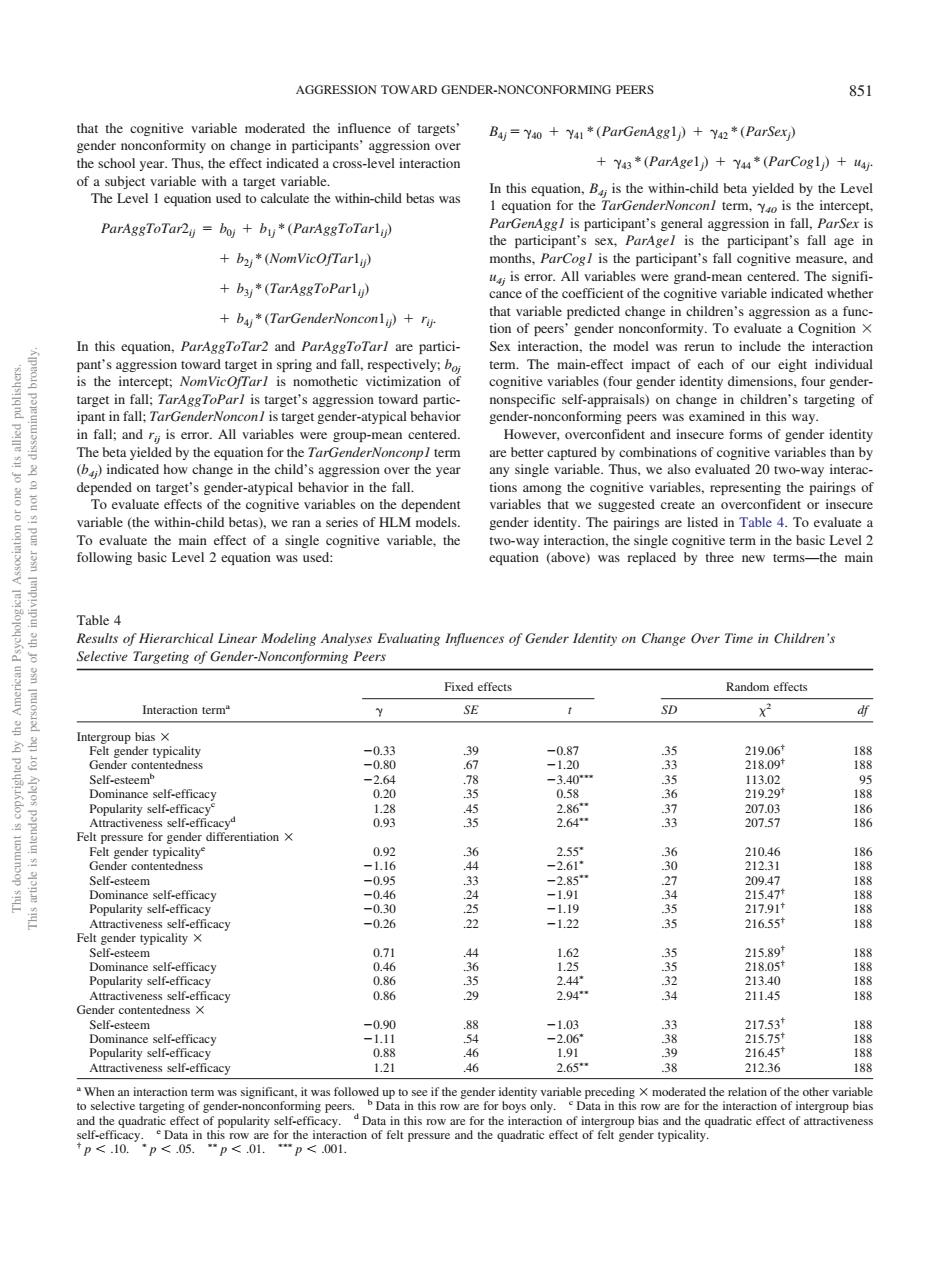正在加载图片...

AGGRESSION TOWARD GENDER-NONCONFORMING PEERS 851 that the cognitive variable moderated the influence of targets' +yaa*(ParAgel)+ya*(ParCogl,)+ta ParAggToTar2y=bo+by*(ParAggToTarl +b2*(NomVicOfTarlu) nths.ParCogl is the participant's fall cognitive meas +by*(TarAggToParl) The main-effect impact of ach of our eight individua sion tow (fouon chang target gender-atypical behavior e r-nonconform as examined in this way ation for ed by combinations of variables than b ba)in ated how ch n the year single 20 wo-way nr f the cognitive var pendent d create a able (the vithin ngare list following basic Level 2 equation wasused: equation (above)was replaced by three new terms the main e ua Selective Targeting of Gender-Nonconforming Peers f Gender Ider e Over Time in Children'? Fixed effect Random effects Interaction term SE SD 67 cac 3893 21236 8888 nt.Iwthat the cognitive variable moderated the influence of targets’ gender nonconformity on change in participants’ aggression over the school year. Thus, the effect indicated a cross-level interaction of a subject variable with a target variable. The Level 1 equation used to calculate the within-child betas was ParAggToTar2ij b0j b1j * (ParAggToTar1ij) b2j * (NomVicOfTar1ij) b3j * (TarAggToPar1ij) b4j * (TarGenderNoncon1ij) rij. In this equation, ParAggToTar2 and ParAggToTar1 are participant’s aggression toward target in spring and fall, respectively; b0j is the intercept; NomVicOfTar1 is nomothetic victimization of target in fall; TarAggToPar1 is target’s aggression toward participant in fall; TarGenderNoncon1 is target gender-atypical behavior in fall; and rij is error. All variables were group-mean centered. The beta yielded by the equation for the TarGenderNonconp1 term (b4j) indicated how change in the child’s aggression over the year depended on target’s gender-atypical behavior in the fall. To evaluate effects of the cognitive variables on the dependent variable (the within-child betas), we ran a series of HLM models. To evaluate the main effect of a single cognitive variable, the following basic Level 2 equation was used: B4j 40 41 * (ParGenAgg1j ) 42 * (ParSexj ) 43 * (ParAge1j ) 44 * (ParCog1j ) u4j . In this equation, B4j is the within-child beta yielded by the Level 1 equation for the TarGenderNoncon1 term, 40 is the intercept, ParGenAgg1 is participant’s general aggression in fall, ParSex is the participant’s sex, ParAge1 is the participant’s fall age in months, ParCog1 is the participant’s fall cognitive measure, and u4j is error. All variables were grand-mean centered. The significance of the coefficient of the cognitive variable indicated whether that variable predicted change in children’s aggression as a function of peers’ gender nonconformity. To evaluate a Cognition Sex interaction, the model was rerun to include the interaction term. The main-effect impact of each of our eight individual cognitive variables (four gender identity dimensions, four gendernonspecific self-appraisals) on change in children’s targeting of gender-nonconforming peers was examined in this way. However, overconfident and insecure forms of gender identity are better captured by combinations of cognitive variables than by any single variable. Thus, we also evaluated 20 two-way interactions among the cognitive variables, representing the pairings of variables that we suggested create an overconfident or insecure gender identity. The pairings are listed in Table 4. To evaluate a two-way interaction, the single cognitive term in the basic Level 2 equation (above) was replaced by three new terms—the main Table 4 Results of Hierarchical Linear Modeling Analyses Evaluating Influences of Gender Identity on Change Over Time in Children’s Selective Targeting of Gender-Nonconforming Peers Fixed effects Random effects Interaction terma SE t SD 2 df Intergroup bias Felt gender typicality 0.33 .39 0.87 .35 219.06† 188 Gender contentedness 0.80 .67 1.20 .33 218.09† 188 Self-esteemb 2.64 .78 3.40 .35 113.02 95 Dominance self-efficacy 0.20 .35 0.58 .36 219.29† 188 Popularity self-efficacyc 1.28 .45 2.86 .37 207.03 186 Attractiveness self-efficacyd 0.93 .35 2.64 .33 207.57 186 Felt pressure for gender differentiation Felt gender typicalitye 0.92 .36 2.55 .36 210.46 186 Gender contentedness 1.16 .44 2.61 .30 212.31 188 Self-esteem 0.95 .33 2.85 .27 209.47 188 Dominance self-efficacy 0.46 .24 1.91 .34 215.47† 188 Popularity self-efficacy 0.30 .25 1.19 .35 217.91† 188 Attractiveness self-efficacy 0.26 .22 1.22 .35 216.55† 188 Felt gender typicality Self-esteem 0.71 .44 1.62 .35 215.89† 188 Dominance self-efficacy 0.46 .36 1.25 .35 218.05† 188 Popularity self-efficacy 0.86 .35 2.44 .32 213.40 188 Attractiveness self-efficacy 0.86 .29 2.94 .34 211.45 188 Gender contentedness Self-esteem 0.90 .88 1.03 .33 217.53† 188 Dominance self-efficacy 1.11 .54 2.06 .38 215.75† 188 Popularity self-efficacy 0.88 .46 1.91 .39 216.45† 188 Attractiveness self-efficacy 1.21 .46 2.65 .38 212.36 188 a When an interaction term was significant, it was followed up to see if the gender identity variable preceding moderated the relation of the other variable to selective targeting of gender-nonconforming peers. b Data in this row are for boys only. c Data in this row are for the interaction of intergroup bias and the quadratic effect of popularity self-efficacy. d Data in this row are for the interaction of intergroup bias and the quadratic effect of attractiveness self-efficacy. e Data in this row are for the interaction of felt pressure and the quadratic effect of felt gender typicality. † p .10. p .05. p .01. p .001. This document is copyrighted by the American Psychological Association or one of its allied publishers. This article is intended solely for the personal use of the individual user and is not to be disseminated broadly. AGGRESSION TOWARD GENDER-NONCONFORMING PEERS 851�����������������������������������